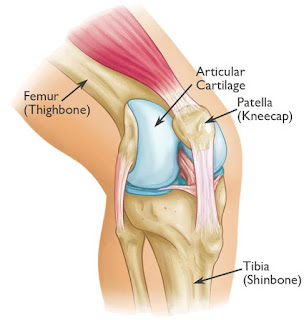Anterior Cruciate Ligament Injury/Tear
ACL TEAR
Anterior Cruciate Ligament Injury/Tear
Anatomy:
Causes of ACL Tear:
The Anterior Cruciate Ligament can be injured in several ways:
1.
Changing Direction rapidly.
2.
Stopping suddenly.
3.
Slowing down while running.
4.
Landing from a jump incorrectly.
5.
Direct contact or collisions, such as football
or rugby tackle
Classification:
About half of all injuries to
the Anterior Cruciate Ligament occur along with the damage to other structures
in the knee, such as cartilage, meniscus or other ligaments.
ü
Injured
ligaments are considered “sprains” and are graded on a severity scale.
Ø
GRADE
1 Injury: The ligament is mildly damaged in Grade 1 injury. It has been
slightly stretched, but is still able to help keep the joint stable.
Ø
GRADE
2 Injury: A Grade 2 injury stretches the ligament to the point where it becomes
loose. This is often referred to as a partial tear of the ligament.
Ø
GRADE
3 Injury: This type of injury is most commonly referred to as a complete tear
of the ligament. The ligament has been split into two pieces, ant the knee
joint is unstable.
ü
Types
of ACL Tear:
Symptoms:
Ø
When
you injure your Anterior Cruciate Ligament, you might hear a “popping’ noise.
Ø
Pain
with swelling – Within 24 hours your knee will swell. If ignored, the swelling
and pain may resolve on its own. However, if you attempt return to sports ,
your knee will probably be unstable and you risk causing further damage to the
cushioning cartilage (MENISCUS) of your knee.
Ø
Loss
of full range of motion.
Ø
Joint
line tenderness present.
Ø
Discomfort
while walking.
Diagnosis:
·
Lachman
test – positive.
·
X-Ray
- will not show any injury to your Anterior Cruciate Ligament, X-Rays can show whether
the injury is associated with a broken bone.
·
MRI
Scan – MRI shows better images of soft tissues like Anterior cruciate ligament.
Treatment:
ACL tear can be treated by either non-surgical or
surgical method.
v
NON-SURGICAL
TREATMENT: In
non-surgical treatment, progressive physical therapy and rehabilitation can
restore the knee to a condition to its pre-injury state and educate the patient
on how to prevent instability. This may be supplemented with the use of hinged
knee brace. However, many people who
choose not to have surgery may experience secondary injury to the knee due to
repetitive instability episodes.
ü
Non-surgical
management of isolated ACL tears is likely to be successful or may be indicated
in patients:
1. with partial tears
and no instability symptoms.
2. Who do light
manual work or live sedentary lifestyles.
3. Whose growth
plates are still not open (children).
v
SURGICAL
TREATMENT:
Surgical treatment is usually advised in dealing with combined injuries. ACL
tears are not usually repaired using suture to sew it back together, because
repaired ACLs is generally replaced by a substitute graft tendon.
The
tendons commonly used to replace the ACL include:
1.
Patellar
tendon autograft (autograft comes from the patient).
2.
Hamstring
tendon autograft .
3.
Quadriceps
tendon autograft .
--The End--






An ACL injury usually and might require ACL Reconstruction Surgery occurs when the Knee is forcefully twisted or hyper extended while the foot remains in contact with the ground.
ReplyDelete